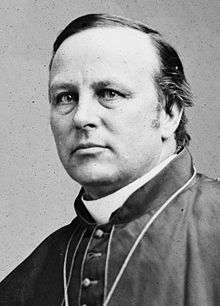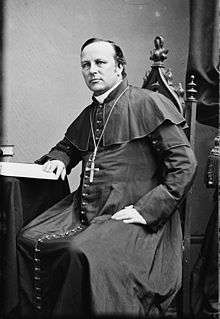James Roosevelt Bayley
| The Most Reverend James Roosevelt Bayley | |
|---|---|
| Archbishop of Baltimore | |
 | |
| See | Baltimore |
| Appointed | June 30, 1872 |
| Installed | October 13, 1872 |
| Term ended | October 3, 1877 |
| Predecessor | Martin John Spalding |
| Successor | James Gibbons |
| Orders | |
| Ordination |
March 2, 1844 by John Hughes |
| Consecration |
October 30, 1853 by Gaetano Bedini |
| Personal details | |
| Born |
August 23, 1814 New York, New York |
| Died |
October 3, 1877 (aged 63) Newark, New Jersey |
| Buried | National Shrine of St. Elizabeth Ann Seton |
| Denomination | Roman Catholic Church |
| Previous post | Bishop of Newark (1853-72) |
James Roosevelt Bayley (August 23, 1814 — October 3, 1877) was an American prelate of the Catholic Church. He served as the first Bishop of Newark (1853–72) and the eighth Archbishop of Baltimore (1872–77).
Early life and education
Bayley was born in New York City, to Guy Carlton Bayley and Grace Roosevelt.[1] His father was the son of Dr. Richard Bayley, a professor at Columbia College who created New York's quarantine system, and the brother of Elizabeth Ann Seton, who was canonized in 1975 as the first American-born Roman Catholic saint.[2] His mother was the daughter of Jacobus Roosevelt and Maria Eliza Walton, a descendant of Joan Beaufort, Countess of Westmoreland. Lady Joan was an ancestor of several Kings of the House of York in England.[3] The eldest of four children, he had two brothers, Carlton and William, and a sister, Maria Eliza.[1] He was also distantly related to President Theodore Roosevelt and President Franklin D. Roosevelt.[4]
Bayley received his early education at the Mount Pleasant Classical Institute in Amherst, Massachusetts.[5] He once considered a career on the sea, hoping to become a midshipman in the U.S. Navy, but later abandoned these plans.[2] He attended Washington College in Hartford, Connecticut, where he earned a Bachelor of Arts degree in 1835.[5] Raised as a Protestant, he decided to enter the Episcopal ministry and studied under the Rev. Samuel Farmar Jarvis in Middletown.[6]
He was ordained a priest in the Episcopal Church on February 14, 1840.[7] He then served as rector of St. Andrew's Church in the Harlem neighborhood of New York City.[1]
Conversion
While serving at St. Andrew's, Bayley became acquainted with a Catholic priest named John McCloskey, who would later become Archbishop of New York and the first American cardinal, and became increasingly drawn to Catholicism.[5] He briefly served as rector of St. John's Church in Hagerstown, Maryland, before traveling to Rome, where he was received into the Catholic Church.[7] He received a conditional baptism on April 19, 1842, and received Confirmation and First Communion on the following April 28.[1]
Bayley traveled throughout Europe for over a year following his conversion, and entered the Seminary of Saint-Sulpice in Paris in August 1843.[6] He returned to New York and there completed his studies at St. John's College in Fordham.[8]
Catholic priesthood
On March 2, 1844, Bayley was ordained a Catholic priest by Bishop John Hughes at St. Patrick's Cathedral.[9] His maternal grandfather, who had made Bayley heir of his large fortune, removed him from his will after his ordination.[4] He was appointed vice-president of St. John's College, where he also served as professor of rhetoric and belles-lettres.[1] He was acting president in 1846 and later served as a pastor in New Brighton, Staten Island.[2] From 1848 to 1853, he was private secretary to Bishop Hughes.[7] He published "A Brief Sketch of the Early History of the Catholic Church on the Island of New York" in 1853.[2]
First Bishop of Newark

On October 30, 1853 Bayley was consecrated the first bishop of the Diocese of Newark. Bayley's mission for the fledgling Diocese was to establish Catholic education as he said, "In our present position, the schoolhouse has become second in importance to the House of God itself ... [our ambition is to have] ... every Catholic child in the state in a Catholic school."
Bayley realized that in order to be effective in his mission he needed the help of a Diocesan community; as he put it, "no one can fill that most important office so effectually as religious women." In 1857 a group of Benedictine Sisters arrived from Pennsylvania and in the following year Bayley sent five women to train with the Sisters of Charity. Many other communities of religious men and women joined the Diocese in the next decades.
When the Diocese of Newark was established he was named its first bishop and consecrated 30 October 1853, in St. Patrick's Cathedral, New York, by Archbishop Gaetano Bedini, the Apostolic Nuncio to Brazil, who was then en route to Rome. The Bishops of Brooklyn and Burlington were consecrated at the same time, the first occurrence of such an elaborate ceremony in the United States. Bishop Bayley's work of organizing the new diocese was not easy. He had more than 40,000 Catholics, mainly of Irish and German extraction, with only twenty-five priests to minister to them. There was not a single diocesan institution, no funds, and poverty on all sides. He therefore applied for help to the Association of the Propagation of the Faith of Lyons, France, and to the Leopoldine Association of Vienna and from both received material assistance.
Bishop Bayley saw need for a Catholic college, and on September 1, 1856 the need was filled by the opening of Chegary Academy (Old Seton Hall) in Madison. In 1860 the school moved to its present location in South Orange and was incorporated into a college by the state of New Jersey in 1861. The College also had a seminary which was necessary for educating new priests. Despite the original need, the number of new recruits exceeded the abilities of the seminary. Bayley was instrumental in the founding of the North American College in Rome at the request of Pope Pius IX, where he sent a young seminarian by the name of Michael Corrigan.
In a letter he wrote April 10, 1865, reviewing the condition of the diocese after his first ten years there he says:
I find that while the Catholic population has increased a third, the churches and priests have doubled in number. In 1854 there was no religious community. Now we have a monastery of Benedictines, another of Passionists, a mother-house of Sisters of Charity, conducting seventeen different establishments; two convents of Benedictine nuns, two others of German Sisters of Notre Dame and two others of the Sisters of the Poor of St. Francis. In 1854 there was no institution of learning; to-day we have a flourishing college and a diocesan seminary, an academy for young ladies, a boarding school for boys, and parish schools attached to almost all the parishes.
In addition to these he introduced the Jesuits and the Sisters of St. Joseph and of St. Dominic into the diocese, and was one of the strongest upholders of the temperance movement of the seventies. He made several journeys to Rome and the Holy Land, attending the canonization of the Japanese martyrs at Rome in 1862; the centenary of the Apostles in 1867; and the ecumenical Council in 1869.
Bishop Bayley served the developing Diocese for 19 years until he was appointed Archbishop of Baltimore on July 30, 1872.
Archbishop of Baltimore

At the death of Archbishop Spalding of Baltimore he was promoted, on July 30, 1872, to succeed that prelate. He left Newark with much reluctance. In 1875 as Apostolic Delegate he imposed the cardinal's biretta on Archbishop John McCloskey of New York. In May, 1876, he consecrated the Baltimore cathedral, having freed it from debt.
Convening the Eighth Provincial Synod of the clergy, August, 1875, he enacted many salutary regulations, particularly with regard to clerical dress, mixed marriages, and church music. Illness obliged him to ask for a coadjutor and Bishop James Gibbons of Richmond was appointed to that position May 29, 1877. The archbishop then went abroad to seek for relief, but in vain. He returned to his former home in Newark in August, 1877, and after lingering for two months, died in his old room, where he had laboured for so long in Newark, New Jersey, on October 3, 1877.
Shortly before Bayley died he spoke of himself by saying, "I am Archbishop; I have been Bishop; but I like Father Bayley best of all." At his own request he was buried beside his aunt, Mother Seton, at the convent at Emmitsburg, Maryland.
In conversation he once told the ultramontane Bishop Michael Corrigan that before his conversion he thought of becoming a Jesuit, and before his consecration a Redemptorist, but from both intentions his director dissuaded him. In addition to the volume on the Church on New York he wrote the Memoirs of Simon Gabriel Brute, First Bishop of Vincennes (New York, 1855), about Simon Bruté.
Episcopal Lineage and Apostolic Succession
- Bishop James Roosevelt Bayley (1853)
- Cardinal Gaetano Bedini (1852)
- Cardinal Luigi Lambruschini (1819)
- Cardinal Giulio Maria della Somaglia (1788)
- Cardinal Hyacinthe-Sigismond Gerdil (1777)
- Cardinal Marcantonio Colonna (1762)
- Pope Carlo della Torre Rezzonico (1743)
- Pope Prospero Lorenzo Lambertini (1724)
- Pope Pietro Francesco Orsini, O.P. (1675)
- Cardinal Paluzzo Paluzzi Altieri degli Albertoni (1666)
- Cardinal Ulderico Carpegna (1630)
- Cardinal Luigi Caetani (1622)
- Cardinal Ludovico Ludovisi (1621)
- Archbishop Galeazzo Sanvitale (1604)
- Girolamo Bernerio, O.P. (1586)
- Cardinal Giulio Antonio Santorio (1566)
- Cardinal Scipione Rebiba
See also
References
- 1 2 3 4 5 Clarke, Richard Henry (1888). Lives of the Deceased Bishops of the Catholic Church in the United States. III. New York.
- 1 2 3 4 "James Roosevelt Bayley". Catholic Encyclopedia.
- ↑ Harrison, Bruce The Family Forest Descendants of Lady Joan Beaufort Millisecond Publishing, 2005
- 1 2 McNamara, Pat (2011-06-20). "The Setons, the Bayleys, and the Roosevelts". Patheos.
- 1 2 3 "Most Rev. James Roosevelt Bayley". Roman Catholic Archdiocese of Baltimore.
- 1 2 Shea, John Gilmary (1886). The Hierarchy of the Catholic Church in the United States. New York: Catholic Publications.
- 1 2 3 "Shepherds of the Seminary". Seton Hall University.
- ↑ "Bishop James Roosevelt Bayley, D.D.". Roman Catholic Archdiocese of Newark.
- ↑ "Archbishop James Roosevelt Bayley". Catholic-Hierarchy.org.
External links
| Catholic Church titles | ||
|---|---|---|
| Preceded by erected |
Bishop of Newark 1853 – 1872 |
Succeeded by Michael A. Corrigan |
| Preceded by Martin John Spalding |
Archbishop of Baltimore 1872 – 1877 |
Succeeded by James Gibbons |

